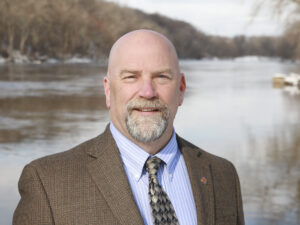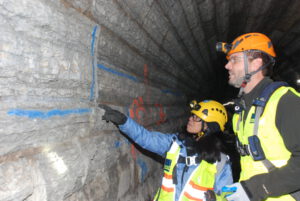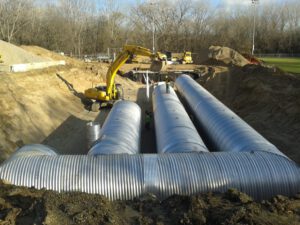In October 2017, the Water Environment Federation’s (WEF) National MS4 Stormwater and Green Infrastructure Awards program recognized the Capitol Region Watershed District (CRWD), located in St. Paul, Minnesota, as the overall best score winners of the Phase II division. With its commitment to creating collaborative partnerships throughout the community, drive to collect and reuse storm water from new sources, and devotion to using groundbreaking technology to enhance their system, it is easy to see how CRWD leads the pack in storm water management.
Tyler Young, a writer for Municipal Water Leader, spoke with CRWD’s administrator, Mark Doneux, about the district’s efforts to collect and use storm water in innovative ways. Throughout the interview, Mr. Doneux speaks about the challenges; the solutions; and, ultimately, the path CRWD has taken to become a leader in storm water management.
 Tyler Young: Can you tell us about your background in the water industry and your time with CRWD?
Tyler Young: Can you tell us about your background in the water industry and your time with CRWD?
Mark Doneux: I have been fortunate to work for 33 years in the water resources and watershed management sector. During the first 10 years of my career, I was in the private sector, working in the consulting industry. For the last 23 years, I have been in the public sector, and for the last 15 years, I have been the administrator for CRWD in St. Paul, Minnesota.
Tyler Young: Could you provide a brief history of CRWD, including its mission and the services it provides to the area?
Mark Doneux: Watershed districts are somewhat unique to the state of Minnesota. The idea for the watershed district started in the 1950s with the need to have an autonomous unit of government that couldimplement flood control projects spanning multiple cities or counties. As you know, water does not follow political boundaries. The state of Minnesota created these watershed districts because it wanted local units of government focused on water management, specifically watersheds, water reuse, and water resources. What is unique about districts is that they have regulatory authority, taxing authority, and some broader authorities to pursue projects that span different political boundaries.
Fast forward to the 1990s, and one of our major lakes in the St. Paul area, Como Lake, was becoming impaired, and the residents wanted more to be done at the local level to deal with flooding, erosion, and water quality on a local level. They petitioned the state to create CRWD, and we were formed 20 years ago in 1998.

Our mission is to protect, manage, protect, and improve the water resources of the district. We do that through five major areas. We have a watershed regulatory program that requires permits on developments. We do extensive monitoring of and research on storm water and its best management practices. We implement our own projects for flood control and water quality improvements. Recognizing that we cannot do it all on our own, we have an active watershed education and outreach program. We also provide financial and technical assistance for individuals, businesses, and organizations that are not regulated, but that choose to pursue storm water best practices on their own. Finally, we also own and operate a 6 -mile-long storm sewer interceptor tunnel system that receives drainage from four of our five cities.
Tyler Young: What are the storm water management challenges in your watershed district?
Mark Doneux: The biggest challenge we face is impervious surfaces. Research shows that when a watershed becomes more than 10 percent impervious, water resources are affected. Our watershed is made up of over 40 percent impervious surfaces. Many of our streams have been put into pipes, and many of our wetlands have been filled. While impervious surfaces are one of our challenges, people are too. We have about a quarter of a million people in our watershed. One in 20 Minnesotans lives in our watershed, and their activities can have negative consequences for our water resources. Beyond that, we have more traditional challenges with storm water management, such as working in an urban environment and retrofitting the system. In addition, we have degraded soils, and in a few areas, we have shallow bedrock.
Tyler Young: What are the main elements of your storm water program, and how do underground treatment systems factor into the program overall?
Mark Doneux: One of our main programs we have is a regulatory program. It is the foundation for many of things that we do. In addition, CRWD provides financial and technical assistance to entities that may want to go above the bare minimum of work. Within the regulatory program, we will see a lot more underground treatments, and a fairly common occurrence is perforated piping under a parking lot to meet rate and volume control standards. In fact, an analysis was done along the Green Line light rail transit system, and about 68 percent of the projects under our permits were using a combination of all underground or partially underground systems.
Tyler Young: Can you provide some examples of other storm water projects you are pursuing?
Mark Doneux: One project in particular blends two elements—technology and storm water reuse. We have a lake that is meeting water quality standards, Lake McCarrons. The goal was to prevent degradation by collecting and reusing storm water and allowing it to soak back into the ground. We first built a cistern that collects storm water. The cistern is used to irrigate a ball field, and we added technology that would divert and drain the cistern in advance of a storm. The water goes into large perforated pipes. That water soaks back into the ground and replenishes the aquifer. That cistern is then empty and available to receive new water.
 The other is more on a partnership basis. We recently completed a project with the City of St. Paul’s Public Works Department and the St. Paul Public Schools to build a regional treatment system on school property that receives runoff from school property and the public road rightof-way. Our three entities collaborated on the design and construction agreement, which includes storm water credits, and long-term operation and maintenance plans shared by all three parties. It is really the first time that we have moved a public road right-of-way water out of the right-of-way and onto another owner’s property—the school.
The other is more on a partnership basis. We recently completed a project with the City of St. Paul’s Public Works Department and the St. Paul Public Schools to build a regional treatment system on school property that receives runoff from school property and the public road rightof-way. Our three entities collaborated on the design and construction agreement, which includes storm water credits, and long-term operation and maintenance plans shared by all three parties. It is really the first time that we have moved a public road right-of-way water out of the right-of-way and onto another owner’s property—the school.
We worked to create a system that was removing runoff and pollutants that would have drained into the Como Lake. The school district spent the same amount of money and not only addressed its regulatory requirements, but also was able to add additional storm water credits due to the efficiency of the storm water system. The city of St. Paul, in turn, will be maintaining the pretreatment system, contributing financial support, and receiving credits for its projects as well. From our viewpoint, we get a significant project that is removing nutrients that would otherwise be going into an impaired body of water. I hope that we will be doing a lot more of these projects in the future.
Tyler Young: Can you tell us about some of the benefits these projects have had on your watershed district?
Mark Doneux: I will say that over 10 years ago, we developed and adopted our 1-inch volume retention standard. I think the benefits of doing what we have for over a decade, from a regulatory standpoint, is that we have been able to demonstrate the feasibility and effectiveness of this approach. Every applicant has been able to comply with our standards, and we have only issued a handful of variances. In the end, it is a benchmark to say that we are on the right path with our program.
 Tyler Young: Could you describe the National MS4 Stormwater and Green Infrastructure Award and what it means?
Tyler Young: Could you describe the National MS4 Stormwater and Green Infrastructure Award and what it means?
Mark Doneux: WEF started the National MS4 Stormwater and Green Infrastructure Awards program in partnership with the U.S. Environmental Protection Agency. Organizations submit a nomination form. WEF reviews and considers basic program management and the six minimum control measures, as well as innovation, technology, leadership, training, and financing. It is an incredible honor to have received the overall highest score for the awards program.
Tyler Young: Where do you see the future of storm water management in your watershed district?
Mark Doneux: There is something we talk about here called shared stacked green infrastructure. Shared meaning multiple entities sharing the same system so that each is not individually building its own system. It is more efficient to have a common system, especially on these larger developments, so we think sharing is in the future. By stacked, I mean stacked benefits. There are open spaces and green spaces and opportunities for wildlife, and greenhouse gas reduction is associated with all these projects. Then these projects have the green infrastructure aspect as well. I talked earlier about these underground systems, and while they are effective at flood control and pollutant removal, they are fairly single purpose. Stacked green infrastructure, on the other hand, has the added benefit of green space and is more aesthetically pleasing. I think the shared stacked green systems are going to be more and more common in our future.
I also think that innovation is important. We have talked about our innovative practices, but there are new things coming out and we need people in the storm water sector to try them out. The University of Minnesota pioneered the iron-enhanced sand filter a few years ago, which is the innovation we need to see. The filter system pulls out not only the particulate phosphorus, but also the dissolved fraction. In Minnesota, with all our lakes, phosphorus is a limiting nutrient. Technology can optimize and improve efficiencies in CRWD’s existing systems. With climate change, we are seeing more-intense storms, which will force us to retrofit our existing systems to adapt.
Asset management is also important. We are seeing an explosion of projects being built, with one of the most common being bioretention sites, more commonly referred to as rain gardens. The storm water sector is going to have to step up its asset management systems so that we are ensuring the performance of all these systems in the future.
